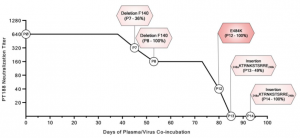A group from Monoclonal Antibody Discovery Lab, Fondazione Toscana Life Sciences, Siena, Italy, etc. has reported on SARS-CoV-2 escaped from neutralizing convalescent plasma in 80days by introducing mutations under the selective pressure of immunity.
https://www.pnas.org/content/118/36/e2103154118.long
An important question for vaccine development is whether the authentic virus, under the selective pressure of the polyclonal immune response in convalescent or vaccinated people, can evolve to fully escape immunity and antibody treatment. To address this question, authors co-incubated the authentic SARS-CoV-2 wild-type (WT) virus and a potent neutralizing plasma with Vero E6 cells for more than 14 passages and 90 days.
The plasma used in the co-incubation experiments was selected from 20 plasmas collected from COVID-19 convalescent patients between March and May 2020 where only the original Wuhan virus and D614G variant (SARS-CoV-2 WT and SARS-CoV-2 D614G variant) were circulating. The plasma (named PT188) showed the highest binding to the SARS-CoV-2 S1–S2 subunits and among the highest binding titers against the RBD (1/1,280).
The plasma fully neutralized the virus for seven passages, but, after seven passages and 45 days, the deletion of F140 in the spike N-terminal domain (NTD) N3 loop led to partial breakthrough. At 11 passages and 73 days, an E484K substitution in the receptor-binding domain (RBD) occurred, followed, at 12 passages and 80 days, by an insertion in the NTD N5 loop containing a new glycan, which generated a variant completely resistant to plasma neutralization.
Mutations with deletions in or near the NTD loops observed in this in vitro experiments were observed in the real world as recent SARS-CoV-2 variants (α、β、γ variants), and the introduction of a glycan is a well-known immunogenic escape strategy observed in a variety of viruses, such as influenza and HIV. Remarkably, the evolution of the E484K substitution observed in this in vitro experimental setting was also replicated in the real world by the emergence of E484K mutation in β and γ variants.

